Hello! @Astro_Jessica Here Ready To Take Your @nasa Questions! @sxsw

Hello! @Astro_Jessica here ready to take your @nasa questions! @sxsw
More Posts from Nasa and Others
Celebrate Earth Day with NASA

"We came all this way to explore the Moon, and the most important thing is that we discovered the Earth." - Apollo 8 astronaut Bill Anders
On Dec. 24, 1968, Anders snapped this iconic photo of "Earthrise" during the historic Apollo 8 mission. As he and fellow astronauts Frank Borman and Jim Lovell became the first humans to orbit the Moon, they witnessed Earth rising over the Moon's horizon. The image helped spark the first #EarthDay on April 22, 1970.
Anders sat down with Dr. Kate Calvin, our chief scientist and senior climate advisor, to chat about the photo, and NASA’s role in studying our home.
Make sure to follow us on Tumblr for your regular dose of space!
What is so special about the solar eclipse to you??
Huh, that’s a very good question and I probably answer it differently each time I get asked it. I love the fact that in totality you can see the solar atmosphere and get a chance to see the magnetic field structure of the Sun. This is something that you can’t normally do. I also love the idea that we’re going to be able to test a bunch of ionospheric models with the help of citizen scientist! This again is a very unique opportunity! But probably the thing that seems so special about this particular eclipse is seeing how excited everyone is about it! Most days I sit in my office working on my science (which I think is the best science and most interesting thing in the world- but I’m probably biased about that) and not too many other people in the world are all that excited about it. But with the eclipse, I get to share how cool this science is, and it’s amazing to see everyone get involved!
What was it like to be in a vessel as it aborted mission? How do you handle a situation like that and continue with future missions?
The Martian Movie and Our Real Journey to Mars
The Martian movie is set 20 years in the future, but here at NASA we are already developing many of the technologies that appear in the film. The movie takes the work we’re doing and extends it into fiction set in the 2030s, when NASA astronauts are regularly traveling to Mars and living on the surface. Here are a few ways The Martian movie compares to what we’re really doing on our journey to Mars:
Analog Missions

MOVIE: In the film, Astronaut Mark Watney is stranded on the Red Planet.
REALITY: In preparation for sending humans to Mars, we have completed one of the most extensive isolation missions in Hawaii, known as HI-SEAS. The goal of this study was to see how isolation and the lack of privacy in a small group affects social aspects of would-be explorers. The most recent simulation was eight months long, and the next mission is planned to last a year.
Spaceport

MOVIE: The Martian movie launches astronauts on the Aries missions from a refurbished and state of the art space center.
REALITY: Currently, the Ground Systems Development and Operations’ primary objective is to prepare the center to process and launch the next-generation vehicles and spacecraft designed to achieve our goals for space exploration. We are not only working to develop new systems, but also refurbishing and upgrading infrastructure to meet future demands.
Deep Space Propulsion

MOVIE: In the film, the astronauts depart the Red Planet using a propulsion system know as the Mars Ascent Vehicle (MAV).
REALITY: We are currently developing the most powerful rocket we’ve ever built, our Space Launch System (SLS). Once complete, this system will enable astronauts to travel deeper into the solar system than ever before! The RS-25 engines that will be used on the SLS, were previously utilized as the main engine on our space shuttles. These engines have proven their reliability and are currently being refurbished with updated and improved technology for our journey to Mars.
Mission Control

MOVIE: In the movie, Mission Control operations support the Aries 3 crew.
REALITY: On our real journey to Mars, Mission Control in Houston will support our Orion spacecraft and the crew onboard as they travel into deep space.
Habitat

MOVIE: The artificial living habitat on Mars in The Martian movie is constructed of industrial canvas and contains an array of life support systems.
REALITY: The Human Exploration Research Analog (HERA), formerly known as the Deep Space Habitat, is a three-story module that was designed and created through a series of university competitions. Studies conducted in habitat mockups will allow us to evolve this technology to create a reliable structures for use on Mars.
Rover

MOVIE: The characters in the film are able to cruise around the Red Planet inside the Mars Decent Vehicle (MDV).
REALITY: We are currently developing a next generation vehicle for space exploration. Our Mars Exploration Vehicle (MEV) is designed to be flexible depending on the destination. It will have a pressurized cabin, ability to house two astronauts for up to 14 days and will be about the size of a pickup truck.
Harvest

MOVIE: Astronaut Mark Watney grows potatoes on Mars in The Martian movie.
REALITY: We’re already growing and harvesting lettuce on the International Space Station in preparation for deep space exploration. Growing fresh food in space will provide future pioneers with a sustainable food supplement, and could also be used for recreational gardening during deep space missions.
Spacesuit

MOVIE: The spacesuit worn by astronauts in the film allows them to work and function on the surface of Mars, while protecting them from the harsh environment.
REALITY: Prototypes of our Z-2 Exploration Suit are helping to develop the technologies astronauts will use to live and work on the the Martian surface. Technology advances in this next generation spacesuit would shorten preparation time, improve safety and boost astronaut capabilities during spacewalks and surface activities.
Uncovering a Massive Meteor Crater Found Lurking Under the Ice

For the first time ever, we've found a massive crater hiding under one of Earth's ice sheets. Likely caused by a meteor, it was uncovered in Greenland by a team of international scientists using radar data.

The data was collected by missions like our Operation IceBridge, which flies planes over Greenland and Antarctica to study the ice and snow at our planet’s poles.

In this case, the crater is near Hiawatha Glacier, covered by a sheet of ice more than half a mile thick. We're pretty sure that the crater was caused by a meteor because it has characteristics traditionally associated with those kinds of impacts, like a bowl shape and central peaks.

It’s also one of the 25 largest impact craters in the world, large enough to hold the cities of Paris or Washington, D.C. The meteor that created it was likely half a mile wide.

Currently, there’s still lots to learn about the crater – and the meteor that created it – but it’s likely relatively young in geologic timescales. The meteor hit Earth within the last 3 million years, but the impact could have been as recent as 13,000 years ago.

While it was likely smaller than the meteor credited with knocking out the dinosaurs, this impact could have potentially caused a large influx of fresh water into the northern Atlantic Ocean, which would have had profound impacts for life in the region at the time.

Go here to learn more about this discovery: https://www.nasa.gov/press-release/international-team-nasa-make-unexpected-discovery-under-greenland-ice

Operation IceBridge continues to uncover the hidden secrets under Earth's ice. IceBridge has been flying for 10 years, providing a data bridge between ICESat, which flew from 2003 to 2009, and ICESat-2, which launched in September. IceBridge uses a suite of instruments to help track the changing height and thickness of the ice and the snow cover above it. IceBridge also measures the bedrock below the ice, which allows for discoveries like this crater.
Make sure to follow us on Tumblr for your regular dose of space: http://nasa.tumblr.com
Urban Growth of New Delhi

The capital of India, New Delhi, has been experiencing one of the fastest urban expansions in the world. Vast areas of croplands and grasslands are being turned into streets, buildings, and parking lots, attracting an unprecedented amount of new residents. By 2050, the United Nations projects India will add 400 million urban dwellers, which would be the largest urban migration in the world for the thirty-two year period.
These images show the growth in the city of New Delhi and its adjacent areas—a territory collectively known as Delhi—from December 5, 1989 to June 5, 2018.
Most of the expansion in Delhi has occurred on the peripheries of New Delhi, as rural areas have become more urban. The geographic size of Delhi has almost doubled from 1991 to 2011, with the number of urban households doubling while the number of rural houses declined by half. Cities outside of Delhi—Bahadurgarh, Ghaziabad, Noida, Faridabad, and Gurugram—have also experienced urban growth over the past three decades, as shown in these images.
Read more: https://go.nasa.gov/2y32G7h
Make sure to follow us on Tumblr for your regular dose of space: http://nasa.tumblr.com.
Save the Date: 2024 Total Solar Eclipse
On April 8, 2024, a total solar eclipse will travel through Mexico, cross the United States from Texas to Maine, and exit North America along Canada’s Atlantic coast. A total solar eclipse occurs when the Moon passes between the Sun and the Earth, completely blocking the face of the Sun. The sky will darken as if it were dawn or dusk.
Weather permitting, people throughout most of North and Central America, including all of the contiguous United States, will be able to view at least a partial solar eclipse. A partial solar eclipse is when the Moon only covers part of the Sun. People in Hawaii and parts of Alaska will also experience a partial solar eclipse. Click here to learn more about when and where the solar eclipse will be visible: go.nasa.gov/Eclipse2024Map
Not in the path of the eclipse? Join us online to watch the eclipse with NASA. Set a reminder to watch live: https://go.nasa.gov/3V2CQML
Make sure to follow us on Tumblr for your regular dose of space!
From Seed to Market: How NASA brings food to the table
Did you know we help farmers grow some of your favorite fruits, veggies and grains?
Our Earth-observing satellites track rainfall amounts, soil moisture, crop health, and more. On the ground, we partner with agencies and organizations around the world to help farmers use that data to care for their fields.
Here are a few ways we help put food on the table, from planting to harvest.
Planting

Did you plant seeds in science class to watch them sprout and grow? They all needed water, right? Our data helps farmers “see” how moist the soil is across large fields.
“When you’re not sure when to water your flowers or your garden, you can look at the soil or touch it with your hands. We are sort of ‘feeling’ the soil, sensing how much water is in the soil – from a satellite,
685 kilometers (408 miles) above Earth,” said John Bolten, the associate program manager of water resources for NASA’s Applied Sciences Program.
This spring, we worked with the U.S. Department of Agriculture and George Mason University to release Crop-CASMA, a tool that shows soil moisture and vegetation conditions for the United States. Able to see smaller areas – about the size of a couple of golf courses – the USDA uses Crop-CASMA to help update farmers on their state’s soil moisture, crop health and growing progress.
Growing

It’s dangerous being a seedling.
Heavy spring rains or summer storms can flood fields and drown growing plants. Dry spells and droughts can starve them of nutrients. Insects and hail can damage them. Farmers need to keep a close eye on plants during the spring and summer months. Our data and programs help them do that.

For example, in California, irrigation is essential for agriculture. California’s Central Valley annually produces more than 250 types of crops and is one of the most productive agricultural regions in the country – but it’s dry. Some parts only get 6 inches of rain per year.
To help, Landsat data powers CropManage – an app that tells farmers how long to irrigate their fields, based on soil conditions and evapotranspiration, or how much water plants are releasing into the atmosphere. The warmer and drier the atmosphere, the more plants “sweat” and lose water that needs to be replenished. Knowing how long to irrigate helps farmers conserve water and be more efficient. In years like 2021, intense droughts can make water management especially critical.
Harvest
Leading up to harvest, farmers need to know their expected yields – and profits.
GEOGLAM, or the Group on Earth Observations Global Agricultural Monitoring Initiative, is a partnership between NASA Harvest, USDA’s Foreign Agricultural Service (FAS) and other global agencies to track and report on crop conditions around the world.
USDA FAS is one of the main users of a soil moisture measurement product developed by Bolten and his team at our NASA Goddard Space Flight Center to drive their crop forecasting system.
If you’re interested in more ways we support agriculture, stay tuned over the next few weeks to learn more about how satellites (and scientists) help put snacks on your table!
Make sure to follow us on Tumblr for your regular dose of space!
First All-Woman Spacewalk
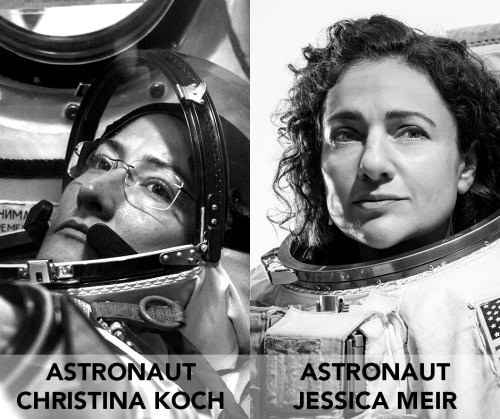
NASA astronauts and best friends, Christina Koch and Jessica Meir, made history Friday, October 18, 2019, by conducting the first all-woman spacewalk outside the International Space Station (ISS)! The Expedition 61 flight engineers ventured into the vacuum of space at 7:38 a.m. EDT to swap out a failed power controller that regulates the batteries used to collect and distribute power to the orbital laboratory – a task that took a total of seven hours and 17 minutes to complete.
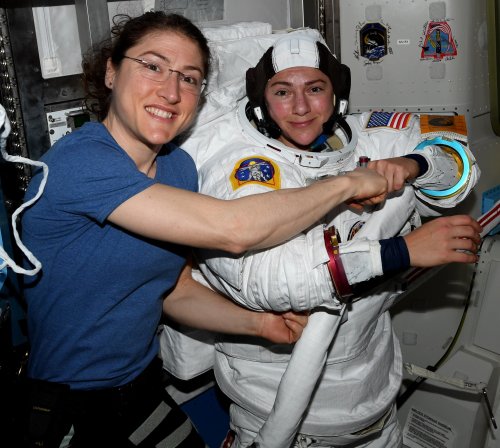
This was Koch’s fourth spacewalk and Meir’s first. Both women, selected as astronaut candidates in 2013, are on their first trip to work and live aboard the space station. Meir will be the 15th woman to spacewalk, and the 14th U.S. woman.
Get to know the astronauts
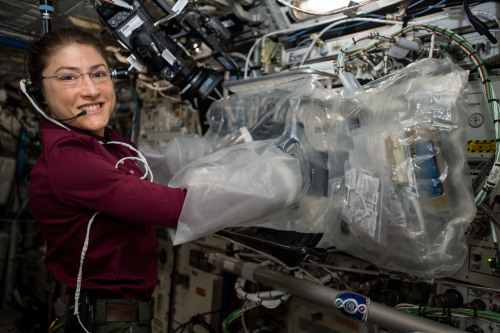
In addition to being an astronaut, Christina Koch is an engineer and physicist. Her career has taken her to extreme parts of the planet to conduct scientific field missions in places like the Antarctic South Pole and Greenland’s Summit Station. Prior to being selected as an astronaut candidate in 2013, she worked as an Electrical Engineer at our Goddard Space Flight Center’s Laboratory for High Energy Astrophysics.
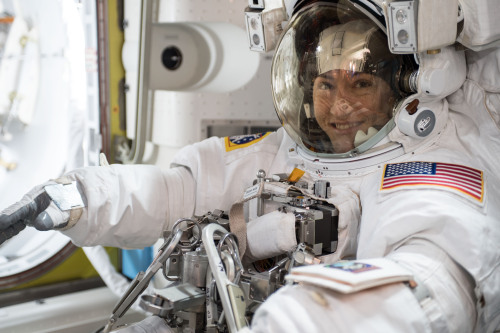
Koch left Earth on March 14, 2019, and is slated to set a record for the longest single spaceflight by a woman with an expected total of 328 days in space. Her extended mission will provide researchers the opportunity to observe the effects of long-duration spaceflight on a female body in preparation for human missions to the Moon and Mars.
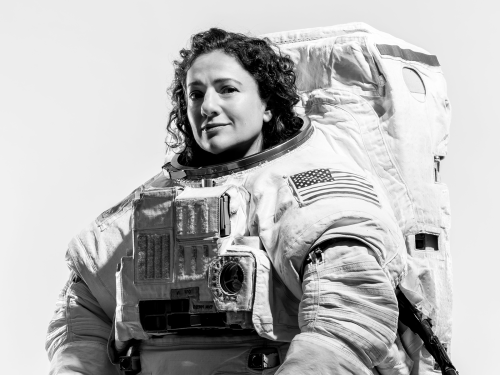
Jessica Meir dreamed of the day she would make it to space since the age of five. That dream became a reality on Wednesday, Sept. 25, 2019 as she left Earth on her first spaceflight – later floating into her new home aboard the International Space Station.
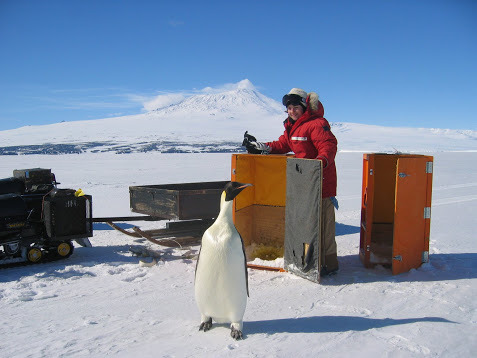
While Meir’s new home is more than 200 miles over the Earth, she is no stranger to extreme environments. She studied penguins in Antarctica and mapped caves in Italy – both of which prepared her for the ultimate extreme environment: space.
#AllWomanSpacewalk, what’s the deal?
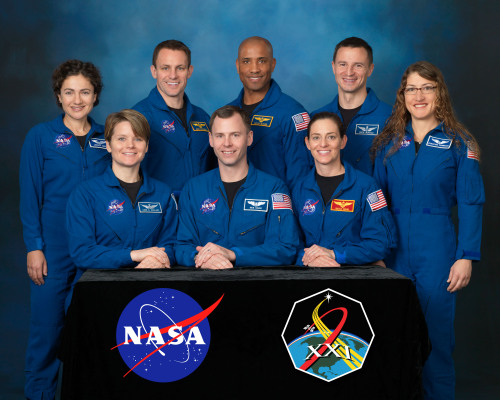
The all-woman spacewalk wasn’t something we purposefully planned; it is a testament to the increasing number of female astronauts in the space program. For example, Koch’s and Meir’s 2013 class of astronaut candidates was 50 percent women!
When asked in an interview about the importance of conducting her mission and this spacewalk, Koch said,
“In the end, I do think it’s important, and I think it’s important because of the historical nature of what we’re doing. In the past women haven’t always been at the table. It’s wonderful to be contributing to the space program at a time when all contributions are being accepted, when everyone has a role. That can lead in turn to increased chance for success. There are a lot of people who derive motivation from inspiring stories of people who look like them, and I think it’s an important story to tell.”
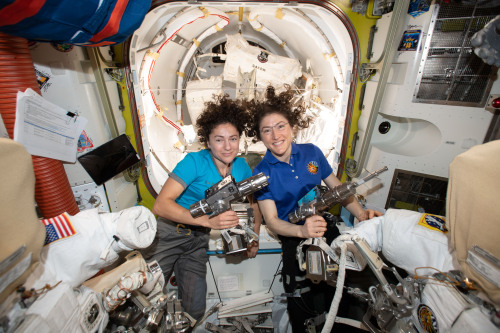
It’s important to note that spacewalks are not easy; astronauts typically describe them as the most physically challenging thing they do. Assignments are made on the basis of which astronauts are the best prepared to accomplish the tasks at hand under the conditions at the time. Today, Koch and Meir were the top astronauts for the job.
Women are no stranger to spacewalks!

While this was the first spacewalk to be conducted entirely by women, women are no strangers to spacewalks. Exactly 35 years and one week ago, Kathryn Sullivan (pictured above) made her own historic debut as the first U.S. woman to conduct a spacewalk. Since then, a total of 14 women (15 including Jessica) have ventured into the vacuum of space on 40 different spacewalks. Former Astronaut Peggy Whitson performed a record number of 10! From Astronauts to mission directors, women have been making their mark at the agency for decades now. A few of our recent pioneers are:
Astronaut Kate Rubins: First person to sequence DNA in space
Astronaut Peggy Whitson: First woman to command the ISS
Sandra Cauffman: Director of our Earth Science’s Division
Nicola Fox: Director of our Heliophysics Division
Lori Glaze: Director of our Planetary Science Division
Coming soon: The first woman to walk on the Moon
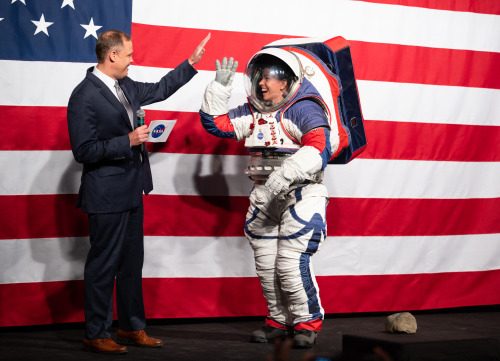
The first all-woman spacewalk is a milestone worth noting and celebrating as we look forward to putting the first woman and the next man on the Moon by 2024 with our Artemis lunar exploration program. With today’s historic event, we once again set a precedence for women to lead in space exploration.
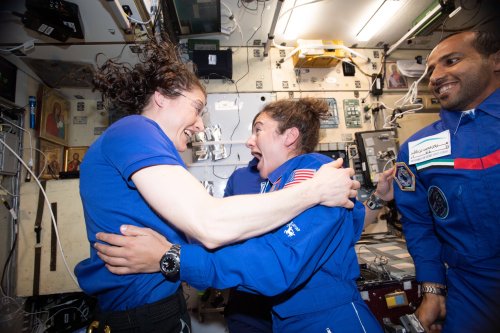
We hope achievements such as this provide inspiration to you all around the world, proving that hard work can lead you to great heights. This is not just a historic day for NASA, but a moment we can all feel proud of.
Didn’t have time to tune in? Check out the replay, here. Koch was wearing the spacesuit with red stripes, while Meir’s had no stripes.
If you’d like to keep up with Christian Koch and Jessica Meir’s work 254 miles above planet Earth, follow them on Twitter at @Astro_ Christina and @Astro_Jessica.
Be sure to follow us on Tumblr for your regular dose of space: http://nasa.tumblr.com
Do you have any protections against asteroids?
-
 john-erby liked this · 3 years ago
john-erby liked this · 3 years ago -
 2reputationpegacorns liked this · 3 years ago
2reputationpegacorns liked this · 3 years ago -
 hialcachofa liked this · 4 years ago
hialcachofa liked this · 4 years ago -
 komandante liked this · 5 years ago
komandante liked this · 5 years ago -
 vahnthedon liked this · 5 years ago
vahnthedon liked this · 5 years ago -
 lostinnwonderlandagain liked this · 5 years ago
lostinnwonderlandagain liked this · 5 years ago -
 summerbrookereding liked this · 5 years ago
summerbrookereding liked this · 5 years ago -
 curiousitylinks-blog reblogged this · 7 years ago
curiousitylinks-blog reblogged this · 7 years ago -
 themotoboy54-blog liked this · 7 years ago
themotoboy54-blog liked this · 7 years ago -
 kutemach liked this · 7 years ago
kutemach liked this · 7 years ago -
 teenagebvrrito liked this · 7 years ago
teenagebvrrito liked this · 7 years ago -
 lisidnc liked this · 7 years ago
lisidnc liked this · 7 years ago -
 luigidombra liked this · 7 years ago
luigidombra liked this · 7 years ago -
 cappuccino-33-blog liked this · 7 years ago
cappuccino-33-blog liked this · 7 years ago -
 jubileestreet1 liked this · 7 years ago
jubileestreet1 liked this · 7 years ago -
 gimihmusqilee-blog liked this · 7 years ago
gimihmusqilee-blog liked this · 7 years ago -
 miniatureloverfurye10-blog liked this · 7 years ago
miniatureloverfurye10-blog liked this · 7 years ago -
 brokenneck liked this · 7 years ago
brokenneck liked this · 7 years ago -
 fransenteppichfussel-blog liked this · 7 years ago
fransenteppichfussel-blog liked this · 7 years ago -
 boredface21 liked this · 7 years ago
boredface21 liked this · 7 years ago -
 qualitylovedragon-blog liked this · 8 years ago
qualitylovedragon-blog liked this · 8 years ago -
 anlidafamy-blog liked this · 8 years ago
anlidafamy-blog liked this · 8 years ago -
 dropsfal liked this · 8 years ago
dropsfal liked this · 8 years ago -
 badw0lfblue liked this · 8 years ago
badw0lfblue liked this · 8 years ago -
 spacedragonsattack liked this · 8 years ago
spacedragonsattack liked this · 8 years ago -
 krishking96112 liked this · 8 years ago
krishking96112 liked this · 8 years ago -
 ou-daro liked this · 8 years ago
ou-daro liked this · 8 years ago -
 aott01 liked this · 8 years ago
aott01 liked this · 8 years ago -
 theonlyparadox reblogged this · 8 years ago
theonlyparadox reblogged this · 8 years ago -
 fairy-footprints liked this · 8 years ago
fairy-footprints liked this · 8 years ago -
 fredhaise liked this · 8 years ago
fredhaise liked this · 8 years ago -
 scaip liked this · 8 years ago
scaip liked this · 8 years ago -
 oursmooth reblogged this · 8 years ago
oursmooth reblogged this · 8 years ago -
 oursmooth liked this · 8 years ago
oursmooth liked this · 8 years ago -
 iseekadventures liked this · 8 years ago
iseekadventures liked this · 8 years ago -
 gecmis-galiba-gelecek liked this · 8 years ago
gecmis-galiba-gelecek liked this · 8 years ago -
 adorkablyqueer liked this · 8 years ago
adorkablyqueer liked this · 8 years ago -
 tissue-paper-blog1 liked this · 8 years ago
tissue-paper-blog1 liked this · 8 years ago -
 gschreck9-blog liked this · 8 years ago
gschreck9-blog liked this · 8 years ago -
 nicolebeatty-blog1 liked this · 8 years ago
nicolebeatty-blog1 liked this · 8 years ago
Explore the universe and discover our home planet with the official NASA Tumblr account
1K posts